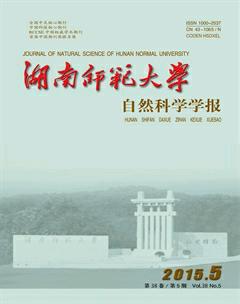连接不同轴向配体铁卟啉体系的自旋非极化和自旋极化密度泛函活性理论研究(英文)
吴文杰 张晓青 惠华英 等
摘要血红素在许多生化反应中起着至关重要的作用,且血红素的核心为卟啉环配位铁离子.文献采用密度泛函活性理论及其自旋极化方法对卟啉环连接的金属离子的选择性进行了研究,发现卟啉环连接铁离子时其结构和活性与连接其他金属离子的体系有很大的差异.实验研究表明,轴向连接不同配体对体系的结构和活性有显著影响.本文采用密度泛函活性理论及其自旋极化方法对铁卟啉体系中铁离子轴向连接不同配体的体系进行系统探究.轴向配体包括 SMe, SHMe, 1H咪唑及衍生物, OH, H2O, H2O2, CO, NO, O2, 呋喃,异吲哚,吡咯和吡啶.通过对全局和局域化学活性描述符的计算分析发现,当配体是CO时,体系化学性质稳定、反应活性也低;在众多种体系中H2O和SHMe的得失质子对体系活性的影响最大.这些计算结果对更深入了解血红素及其类似体系的活性和作用机理有重要意义.
关键词卟啉环; 血红素; 密度泛函活性理论; 自旋密度泛函活性理论
Scheme 1LFe(Ⅱ)porphyrin systems investigated in this work, with L can be replaced by fractional groups in amino acid that usually bonded with heme in nature: from cysteine: MeS-, SHMe, from histidine: 1Himidazole, imidazol1ide, from water: O2-, HO-, H2O, H2O2, and small gaseous molecules: CO, NO, O2, and also some other common ligands: furan, isoindole, pyrrole, pyridineHeme is a metalbinding porphyrin consisting of a heterocyclic organic ring made from four pyrrole subunits linked via methine bridges (Scheme 1). As the core cofactor of hemoproteins, it serves as a prosthetic group for many biological processes including oxidative metabolism[13], xenobiotic detoxification, synthesizing and sensing of diatomic gases, cellular differentiation, gene regulation at the level of transcription, protein translation and targeting, and protein stability. Therefore, hemoproteins such as hemoglobin[4], myoglobin[5], hemocyanin[67] and neuroglobin[8] are abundance in nature and play essential roles in physiological processes as sensors, activators, and carriers of gaseous molecules. Hemoglobin is most commonly found in its oxygenbinding state where the bonded metal cation is a divalent iron, Fe(Ⅱ). When in its resting or functioning state, up to two axial ligands are required to bond with the metal cation in the metalporphyrin complex to carry out the catalytic process. The most common axial residues in hemoproteins are histidine and cysteine.
湖南师范大学自然科学学报第38卷第5期吴文杰等:连接不同轴向配体铁卟啉体系的自旋非极化和自旋极化密度泛函活性理论研究Density functional reactivity theory (DFRT) and spinpolarized DFRT (SPDFRT) have recently been applied to understand the metalbinding specificity of porphyrin[12], where it was found that both structure and electronic properties of the metal cation play important roles in differentiating its metalbinding specificity. Differences in metalbinding specificity of metalporphyrin complexes can result from different causes. For example, no Caporphyrin or Cdporphyrin complex exists in nature because Ca(Ⅱ) and Cd(Ⅱ) cations are too big to fit into the inner cavity of the porphyrin ring. For other complexes such as Zn(Ⅱ) and Mn(Ⅱ), it was concluded that electronic properties, as shown from the secondorder perturbation theory analysis of the Fock matrix in the NBO basis and chemical reactivity descriptors such as hardness, electrophilicity, and dual descriptors, dictate their metalbinding specificity. It has also been revealed that the iron complex differs from other metal ion complexes in bonding and reactivity properties (i.e. charge distribution, stability, and nucleophilicity) when two axial bonds are formed, enhancing and facilitating the role of the iron cation as the center of the catalytic process and thus implying that the number and nature of the axial ligands also play an important role in the catalytic process. Another conclusion from those previous studies in the literature is that Fe(Ⅱ) and Ru(Ⅱ) complexes show similar reactivity from the spin unresolved DFRT perspective, but from the spinpolarized version of DFRT, the Feporphyrin complex stands up and often possesses the smallest value for each of the SPDFRT quantities in most cases, indicating that the Fe system is most likely to increase the total spin number, and the spin resolution showed a remarkable difference between Ru and Fe complexes. These results suggest that the specificity difference of porphyrin between Fe and Ru cations is originated from both the electron and spin properties and that to differentiate their behaviors one has to resort to spin resolved reactivity indices.




